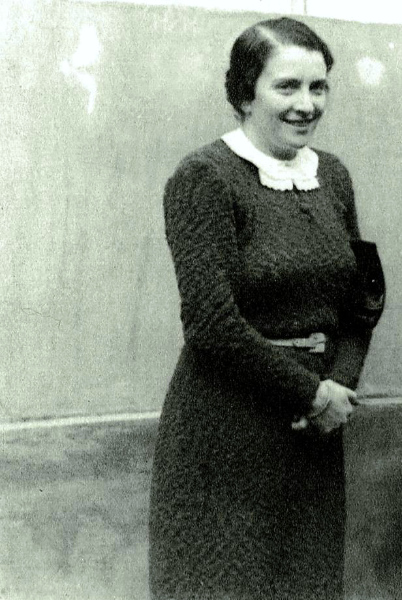Biography
Helene Roth was born on 13 May 1904 in Göding (Hodonín) into a Jewish family. Göding, a small town in southern Moravia is located about 50 km southeast of Brno and at that time belonged to the Austro-Hungarian Empire. As the daughter of the factory owner Ferdinand Roth, Helene attended the secondary school in Brno and graduated at the age of 17.
In the winter semester of 1921/22, she was admitted to the Technische Hochschule Wien (Technical University Vienna) first as an non-degree student and then, from the summer semester of 1922, as a regular student. She passed the I. state exam for architecture on 15 February and the II.state exam on 20 December 1926 and received the title of engineer. At the age of 22, Helene Roth was the first and the youngest woman to graduate in architecture from the Technische Hochschule Wien. Before she became self-employed, she worked for the office of the architect Sobotka.
At the 1930 Internationaler Frauenkongress in Wien (International Women’s Congress) in Vienna, the Bund österreichischer Frauenvereine (Federation of Austrian Women’s Associations) organised a series of tours of modern houses and private apartments to present to interested visitors. Under the motto ‘Modern Living’, the architects who carried out the work showed their apartment furnishings and redesigns. Apartments of Helene Roth could also be visited during these tours. She showed a small and a large apartment, some of which she had furnished together with the architect Albert Gerstner. These were located in a new building at Sieveringerstrasse 23, in 1190 Vienna, and in an older building at Schopenhauer Strasse 74, in 1180 Vienna.
Not only the architect’s choice of colours and fabrics is worth mentioning, but also her gift for making each piece of furniture usable. For the execution of murals and ceramic stoves, she collaborated with renowned artists of the time, such as Maria Strauss-Likarz, a designer and collaborator of the Wiener Werkstätte.
Helene Roth was active as an architect, mainly for residential furnishings, conversions, adaptations, but also for the construction of apartment buildings and villas in Vienna.
In 1934, with the beginning of the Austrofascist era, Antisemitism also increased in Austria and many Jews were pushed to the fringes of society. Most of them had no choice but to go into exile.
This was also the case for Helene Roth: she emigrated to the British Mandate territory of Palestine in 1934. About 60% of all new immigrants who came to Palestine settled in Tel Aviv. Tel Aviv, the heart of the Jewish community in the country, became home to many immigrants fleeing Antisemitism in Europe. In addition to Helene Roth, two other graduates of the Technische Hochschule Wien emigrated to Palestine a short time later: Dora Gad and Anna Klapholz. Before their emigration, these architects were among the first women to attend a technical university in the German-speaking world. Now based and settled in Tel Aviv, they were hired by established architectural firms. Helene Roth joined Alfred Abraham’s office and later became his professional partner. Together they founded Abraham and Roth, Interior Decoration on Sheinkin Street in Tel Aviv. This collaboration lasted from 1934 to 1956.
Several lamp designs by her are known from the 1950s. She designed mainly desk and floor lamps, which were executed in various materials.
Helene Roth focussed on the interior design of homes and stores and became one of the most important interior designers of her time.
Works (selection)
1931 Participation in the exhibition Die schaffende Österreicherin. Werk und Bild, Secession, Vienna
ca. 1933 Design for a single-family house in Vienna (not realised)
1933 Home furnishings as part of the Modernes Wohnen tours
1953-1957 Lamp designs for desk and floor lamps
Sources
Juliane Mikoletzky, Ute Georgeacopol-Winischhofer, Margit Pohl: „Dem Zuge der Zeit entsprechend …“ Zur Geschichte des Frauenstudiums in Österreich am Beispiel der Technischen Universität Wien, WUV-Universitätsverlag Wien, 1997.
Frau Architekt. Seit mehr als 100 Jahren Frauen im Architekturberuf, Ausstellungskatalog Deutsches Architekturmuseum, Frankfurt am Main, 2017, p.49f
Pionierinnen Ausstellung auf der Technischen Universität Wien, Kuppelsaal, 2019
Gisela Urban, Modernes Wohnen. In: Die Österreicherin, Jg. 6, Wien, Juni 1933, p.3-4
Gisela Urban, Wie schaffen Wiener Architektinnen? in: Neue freie Presse, 15.02.1933.
Photo: Helene Roth, ca 1930, Courtesy of the Roth family and Sigal Davidi.
Text: Carmen Trifina
February 2022

